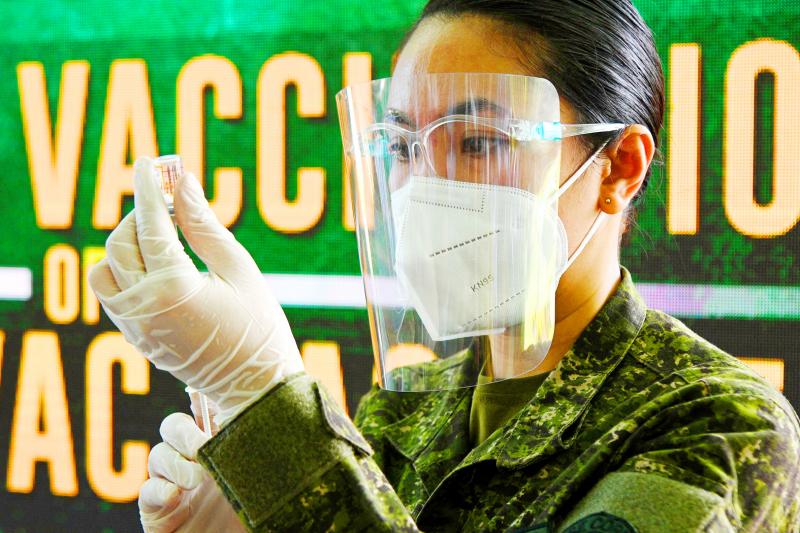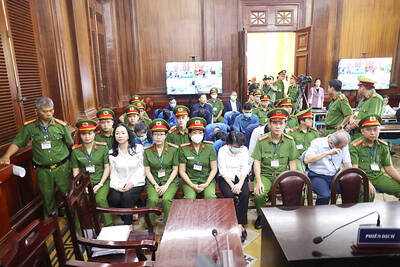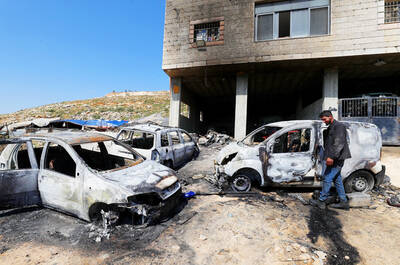The plane laden with vaccines had just rolled to a stop at Santiago’s airport in late January and Chilean President Sebastian Pinera was beaming. “Today is a day of joy, emotion and hope,” he said.
The source of that hope: China — a country that Chile and dozens of other nations are depending on to help rescue them from the COVID-19 pandemic.
China’s vaccine diplomacy campaign has been a surprising success: It has pledged about 500 million doses of its vaccine to more than 45 countries, according to a country-by-country tally by The Associated Press (AP).

Photo: AFP
With just four of China’s many vaccine makers able to produce at least 2.6 billion doses this year, a large part of the world’s population would end up inoculated not with the fancy Western vaccines boasting headline-grabbing efficacy rates, but with China’s humble, traditionally made shots.
Amid a dearth of public data on China’s vaccines, fears over their efficacy and safety are still pervasive in the countries depending on them, along with concerns about what China might want in return for deliveries.
Nonetheless, inoculations with Chinese vaccines have begun in more than 25 countries, and the shots have been delivered to another 11, according to the AP’s tally, based on independent reporting in those countries along with government and company announcements.
It is a potential face-saving coup for China, which has been determined to transform itself from an object of mistrust over its initial mishandling of the COVID-19 outbreak to a savior.
“We’re seeing certainly real-time vaccine diplomacy start to play out, with China in the lead in terms of being able to manufacture vaccines within China and make them available to others,” said Krishna Udayakumar, founding director of the Duke Global Health Innovation Center at Duke University.
China has said it is supplying “vaccine aid” to 53 countries and exports to 27, but it rejected a request by the AP for the list.
Beijing has denied vaccine diplomacy, and a Chinese Ministry of Foreign Affairs spokesperson said China considered the vaccine a “global public good.”
Chinese experts reject any connection between the export of its vaccines and the revamping of its image.
China has targeted the low and middle-income countries largely left behind as rich nations scooped up most of the pricey vaccines produced by the likes of Pfizer and Moderna. Despite a few delays of its own, China has largely capitalized on slower-than-hoped-for deliveries by US and European vaccine makers.
Like many other countries, Chile received far fewer doses of the Pfizer vaccine than promised. Chinese company Sinovac acted quickly, sending in 4 million doses.
The choices are limited for Chile and many other low and middle-income countries. Vaccine deployment globally has been dominated by rich nations, which have snapped up 5.4 billion of the 7.8 billion doses purchased worldwide, Duke University said.
China’s vaccines, which can be stored in standard refrigerators, are attractive to many countries that might struggle to accommodate the ultra-cold storage needs of vaccines like Pfizer’s.
Sinovac and Sinopharm rely on a traditional technology in which a live virus is killed and then purified, triggering an immune response.
Some countries view it as safer than the newer, less-proven technology used by some Western competitors that targets the novel coronavirus’ spike protein, despite the lack of publicly available safety data on the Chinese vaccines.
In Europe, China is providing the vaccine to countries such as Serbia and Hungary — a significant geopolitical victory in Central Europe and the Balkans, where the West, China and Russia are competing for political and economic influence. Hungary is the first EU country to use a Chinese vaccine.
However, China’s vaccine diplomacy would be only as good as the vaccines it is offering, and it still faces hurdles.
“The Chinese vaccine, in particular, there was insufficient data available compared to other vaccines,” said Ahmed Hamdan Zayed, a nurse in Egypt who overcame his initial reluctance and received Sinopharm’s vaccine.
Sinopharm, which said its vaccine was 79 percent effective based on interim data from clinical trials, did not respond to interview requests.
Chinese vaccine companies have been “slow and spotty” in releasing their trial data, compared with companies like Pfizer and Moderna, said Yanzhong Huang (黃嚴忠), a global health expert at the US think tank Council for Foreign Relations.
None of China’s three vaccine candidates used globally have publicly released their late-stage clinical trial data.
CanSino, another Chinese company with a one-shot vaccine that it says is 65 percent effective, declined to be interviewed.
There is also confusion around Sinovac’s efficacy. In Turkey, where Sinovac conducted part of its efficacy trials, officials have said the vaccine was 91 percent effective.
However, in Brazil, officials revised the efficacy rate in late-stage clinical trials from 78 percent to just more than 50 percent after including mild infections.
An expert panel in Hong Kong published data submitted by Sinovac to health regulators that showed the vaccine was just more than 50 percent effective.
Globally, public health officials have said any vaccine that is at least 50 percent effective is useful.
Receiving countries are also worried that China’s vaccine diplomacy might come at a cost. In the Philippines, where Beijing is donating 600,000 vaccines, a senior diplomat said Chinese Minister of Foreign Affairs Wang Yi (王毅) gave a subtle message to tone down public criticism of growing Chinese assertiveness in the disputed South China Sea.
The diplomat said Wang did not ask for anything in exchange for vaccines, but it was clear he wanted “friendly exchanges in public, like control your megaphone diplomacy a little.”
The diplomat spoke on condition of anonymity to discuss the issue publicly.
Still, the pandemic’s urgency has largely superseded hesitations over China’s vaccines.
“Vaccines, particularly those made in the West, are reserved for rich countries,” said one Egyptian official, who spoke on condition of anonymity to discuss the matter. “We had to guarantee a vaccine. Any vaccine.”

Republican US lawmakers on Friday criticized US President Joe Biden’s administration after sanctioned Chinese telecoms equipment giant Huawei unveiled a laptop this week powered by an Intel artificial intelligence (AI) chip. The US placed Huawei on a trade restriction list in 2019 for contravening Iran sanctions, part of a broader effort to hobble Beijing’s technological advances. Placement on the list means the company’s suppliers have to seek a special, difficult-to-obtain license before shipping to it. One such license, issued by then-US president Donald Trump’s administration, has allowed Intel to ship central processors to Huawei for use in laptops since 2020. China hardliners

A top Vietnamese property tycoon was on Thursday sentenced to death in one of the biggest corruption cases in history, with an estimated US$27 billion in damages. A panel of three hand-picked jurors and two judges rejected all defense arguments by Truong My Lan, chair of major developer Van Thinh Phat, who was found guilty of swindling cash from Saigon Commercial Bank (SCB) over a decade. “The defendant’s actions ... eroded people’s trust in the leadership of the [Communist] Party and state,” read the verdict at the trial in Ho Chi Minh City. After the five-week trial, 85 others were also sentenced on

‘DELUSIONAL’: Targeting the families of Hamas’ leaders would not push the group to change its position or to give up its demands for Palestinians, Ismail Haniyeh said Israeli aircraft on Wednesday killed three sons of Hamas’ top political leader in the Gaza Strip, striking high-stakes targets at a time when Israel is holding delicate ceasefire negotiations with the militant group. Hamas said four of the leader’s grandchildren were also killed. Ismail Haniyeh’s sons are among the highest-profile figures to be killed in the war so far. Israel said they were Hamas operatives, and Haniyeh accused Israel of acting in “the spirit of revenge and murder.” The deaths threatened to strain the internationally mediated ceasefire talks, which appeared to gain steam in recent days even as the sides remain far

RAMPAGE: A Palestinian man was left dead after dozens of Israeli settlers searching for a missing 14-year-old boy stormed a village in the Israeli-occupied West Bank US President Joe Biden on Friday said he expected Iran to attack Israel “sooner, rather than later” and warned Tehran not to proceed. Asked by reporters about his message to Iran, Biden simply said: “Don’t,” underscoring Washington’s commitment to defend Israel. “We are devoted to the defense of Israel. We will support Israel. We will help defend Israel and Iran will not succeed,” he said. Biden said he would not divulge secure information, but said his expectation was that an attack could come “sooner, rather than later.” Israel braced on Friday for an attack by Iran or its proxies as warnings grew of